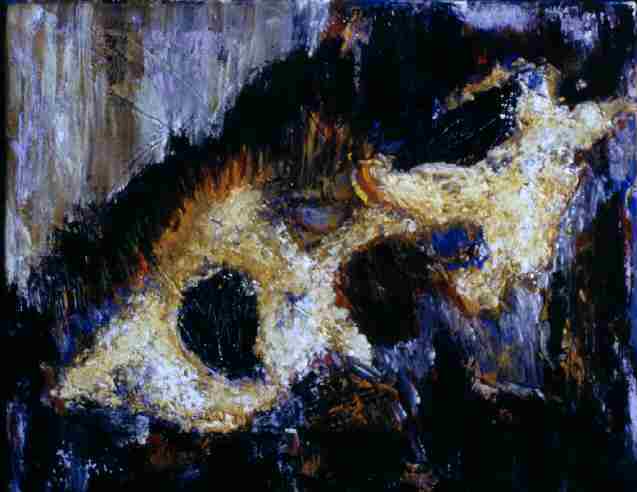![]() INTERCULTURAL
PHILOSOPHY AND ART
INTERCULTURAL
PHILOSOPHY AND ART
 Galerie Inter
Galerie Inter
Paul Celan
The Eye of Time

A painter's interpretation of a poem by Paul Celan
Paul Celan (1920-1970),
a Jewish poet who was born in Rumania, but has written in German, has cooperated
several times with painters and graphic artists, especially with his wife Gisèle
Lestrange-Celan. The main subject of his poetic work is the holocaust. His parents
and his sister have been murdered by the executi oners of the nazis. After World-war
II Celan has lived for a couple of months at Vienna. Finally he has e migrated
to Paris.
Friederike Kimmerle has made three series of paintings which are
related to poems of Celan. A series of five paintings related to the poem ‘Ich
bin allein’, three paintings to ‘Auge der Zeit’ and a dubbelpicture to ‘Stilleben’.
From December 13, 2000 until January 4, 2001, there will be an exhibition, organized
by the Foundation for Intercultural Philosophy and Art, at the gallery ‘De Graanschuur’
in Zoetermeer, where the three series are shown.
On December 14, 2000, at the Goethe-Institute in Rotterdam, a symposium
will be held on the poetic work of Celan. Especially the philosophical interpretations
of certain poems of Celan will be discussed, and there will be reflected also
on the connection between Paul Celan’s poems and Friederike Kimmerle’s paintings.
The paintings which are related to the poem ‘Auge der Zeit’ form
the centre of the three series. That is why The Eye of Time has become the title
of the whole enterprise. First of all an interpretation is given to the attitude
of Celan who is remembering the holocaust all the time. In doing that he feels
‘I am lonly ’. He is mourning his parents and his sister and all the other victims
of the holocaust. That is expressed in his words and in the paintings by the
colour black. But there is also hope or the mourning itself gives some hope
which is expressed in the paintings by the colours yellow, red and blue.
The ‘Eye of Time’ is watching the world of this period of history.
And again there is before all sorrow. But the squint-eyed look of time is situated
under a brow of seven colours. What does that mean? According to the Old Testament,
God has created the world in seven days, and ‘he looked at it and he saw that
it was very good’. And in the history of Jewish belief the candlestick with
seven arms plays an important role. The last two lines of this central poem
render the double attitude of mourning and hoping in a very concentrated way:
‘And the dead are budding and blossoming’.
In the third poem a ‘Still Life’ is sketched by the writer. In
it we encounter again the metaphor of the eye. It is situated under burning
candles which evoke the mood of a funeral. To remember the holocaust leads to
the insight that we are strangers on earth, and that it is infinitely difficult
to find the word to express our feelings. But on the picture there is light
behind the dark thistle.
Introduction by Prof. H. Kimmerle, Foundation for intercultural
philosophy and art - IFK, Zoetermeer
1
2
3
4
5 Das Auge der Zeit - Bilder
zu Gedichten von Paul Celan
![]() Homepage IFK - Intercultural Communication
Homepage IFK - Intercultural Communication
![]() Galerie Inter
Homepage
Galerie Inter
Homepage